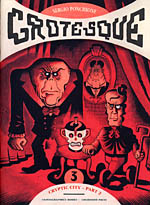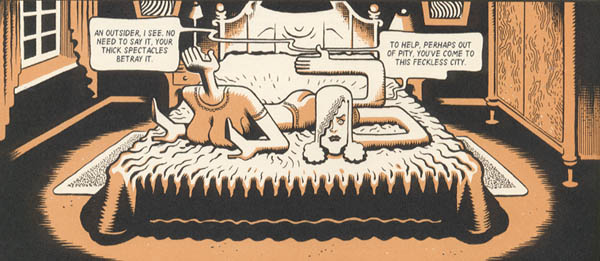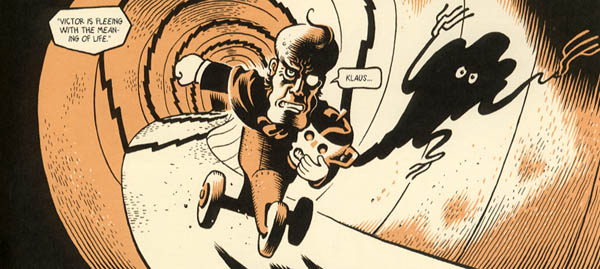 By Sergio Ponchione
By Sergio Ponchione
32 pages, two-color
Published by Fantagraphics Books
One of the things I love about Fantagraphics’s Ignatz Series of comics is how they’ve brought artists and styles from all over the world into a single line. Invariably, half of the books are by artists I’ve never heard of, like Italy’s Sergio Ponchione. I recently bought his Grotesque #2-3, which contained a two-part story, "Cryptic City." His off-beat style of story and art bring to mind almost instantly creators like Richard Sala, and made one thing almost instantly clear: I need to buy Grotesque #1, and soon.
"Cryptic City" sends our hero, Professor Hackensack, to a city where years ago one of the founders sold the townspeople’s abilities to have emotions on their own; now, the Barons sell emotions to the inhabitants and thus prevent them from leaving. That alone is a strong enough concept for a story, and as soon as Ponchione revealed that I was already pleased. What I found, though, was that there’s more to that lurking in the pages of Grotesque. It’s a world with an ink spot that slides along walls and spies on enemies of the Barons, people whose ears are repositioned onto the top of their heads, and the Puzzle Lady that would have made Picasso proud. It’s a noir mystery crushed into a surrealistic adventure, and the two work together excellently under Ponchione’s imagination.

What I think I appreciated the most, right off the bat, about "Cryptic City" was that it felt like a completely realized place. Cryptic City was the kind of place that could have easily contained dozens of stories; considering how many characters appear and clearly have a full back story that we never get, Ponchione could have stretched "Cryptic City" into a much longer work if he wanted. I’d even settle for more stories co-starring Professor Hackensack and Detective Doppiofaccio; the two characters have an almost instant rapport, and by working together they manage to merge their different genres into a cohesive new style.
It’s hard to ignore Ponchione’s gorgeous art in Grotesque #2-3, which is certainly part of their charm. There’s always a certain amount of logic in the strange structures and forms that inhabit "Cryptic City." Take, for instance, the huge spread of the city in the opening scene of Grotesque #3. It’s not impossible in the way that an Escher drawing is, but instead Ponchione goes for a more subtle approach. Buildings zig zag up into the sky in such a way that would be difficult to stay upright, characters with two heads or crooked postures walk by, and buildings are wedged inside the upside-down Vs of rooftops side-by-side. It’s half classical art, half fantastic and absurd, like Roger Langridge drawing a crime fiction.

There’s so much to just look at in Grotesque #2-3 that might otherwise pass you by; the Lady Puzzle puzzle-games, the squid-headed Encephaloctopus, Baron Victor von Cryptic’s lower torso being a tricycle, the trees with their branches that twist and turn at right-angles and look like circuit boards growing up out of the ground. It’s at times like this that the Ignatz Series format is that much more critical. With larger dimensions and high quality paper stock, it lets you examine and enjoy the art that much more. At this point, I’m not sure what I’m hoping for more; additional issues of Grotesque, or other works from Ponchione translated into English. (Regardless, I’m running out and buying Grotesque #1 as soon as possible.) This is a beautifully off-kilter comic. Definitely check it out.
